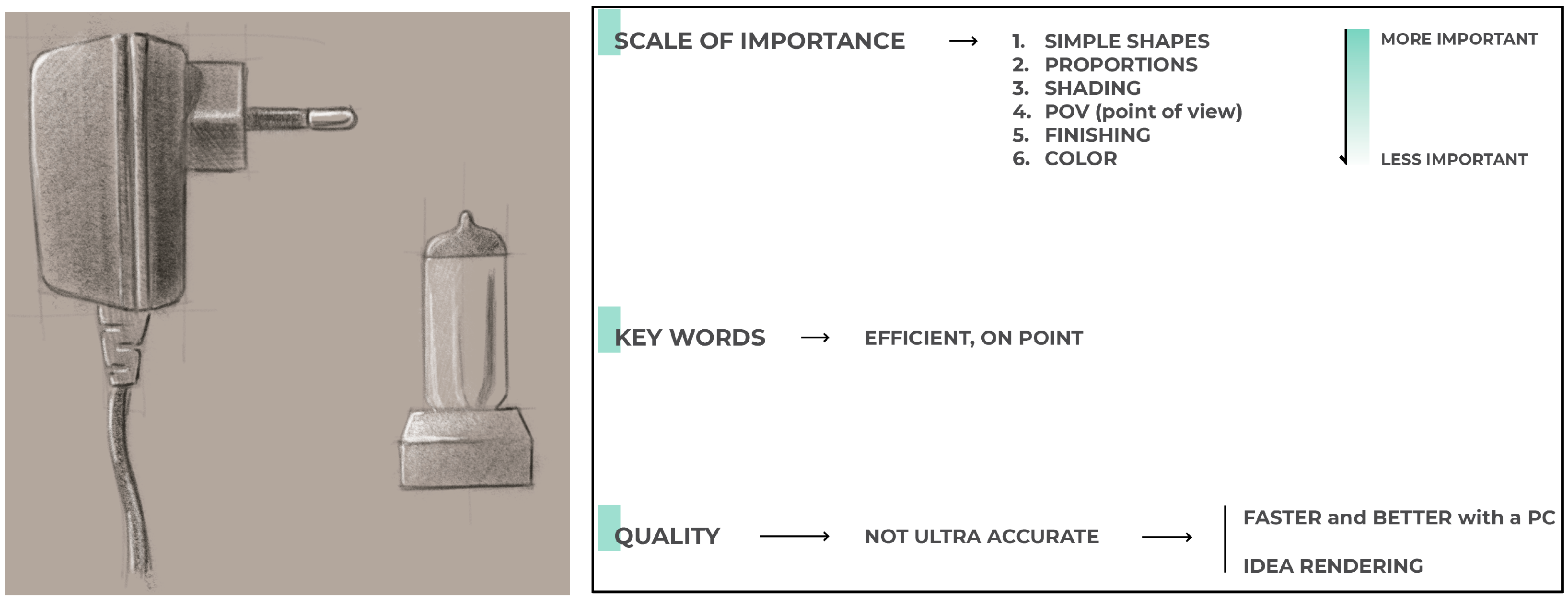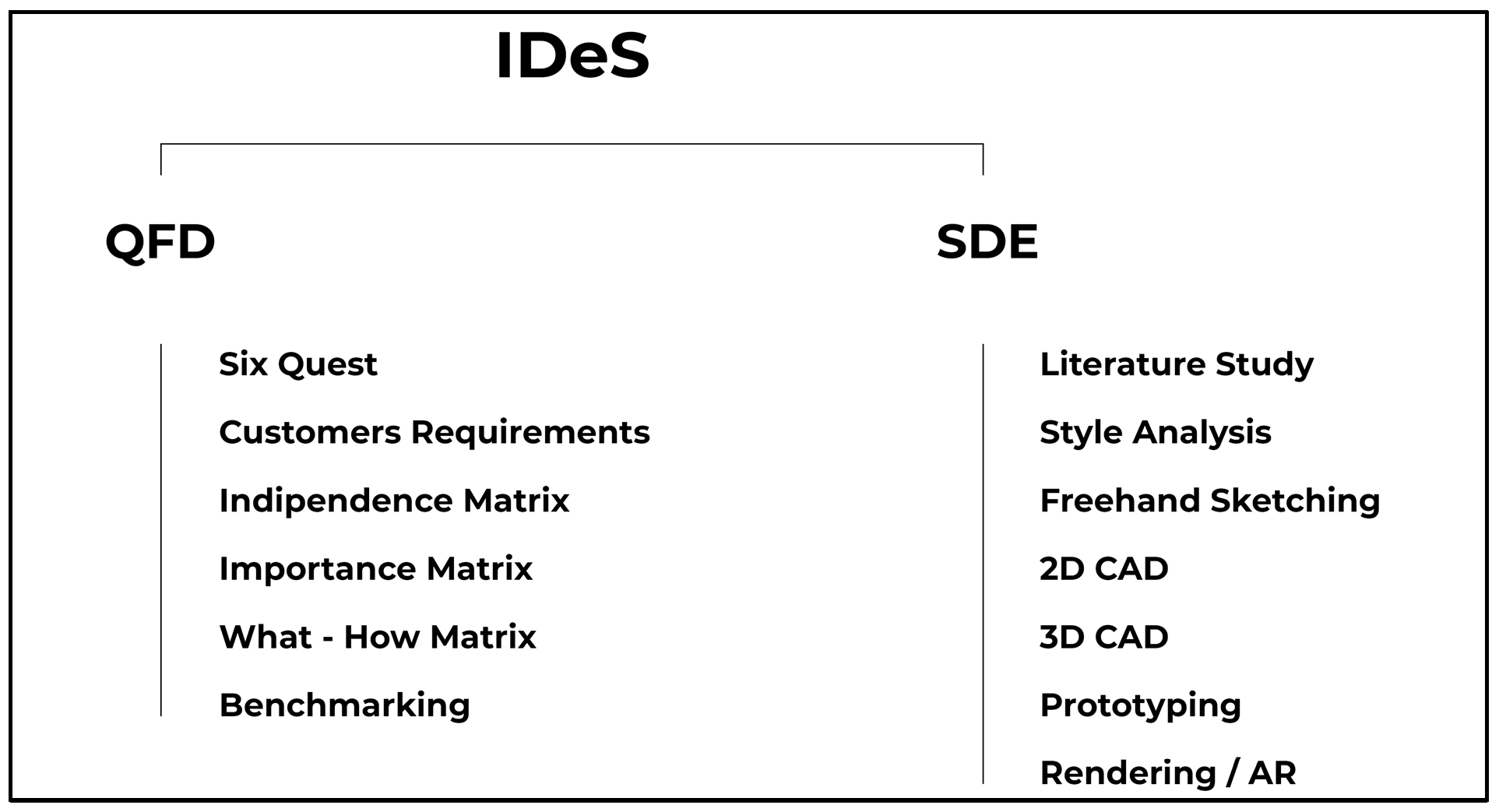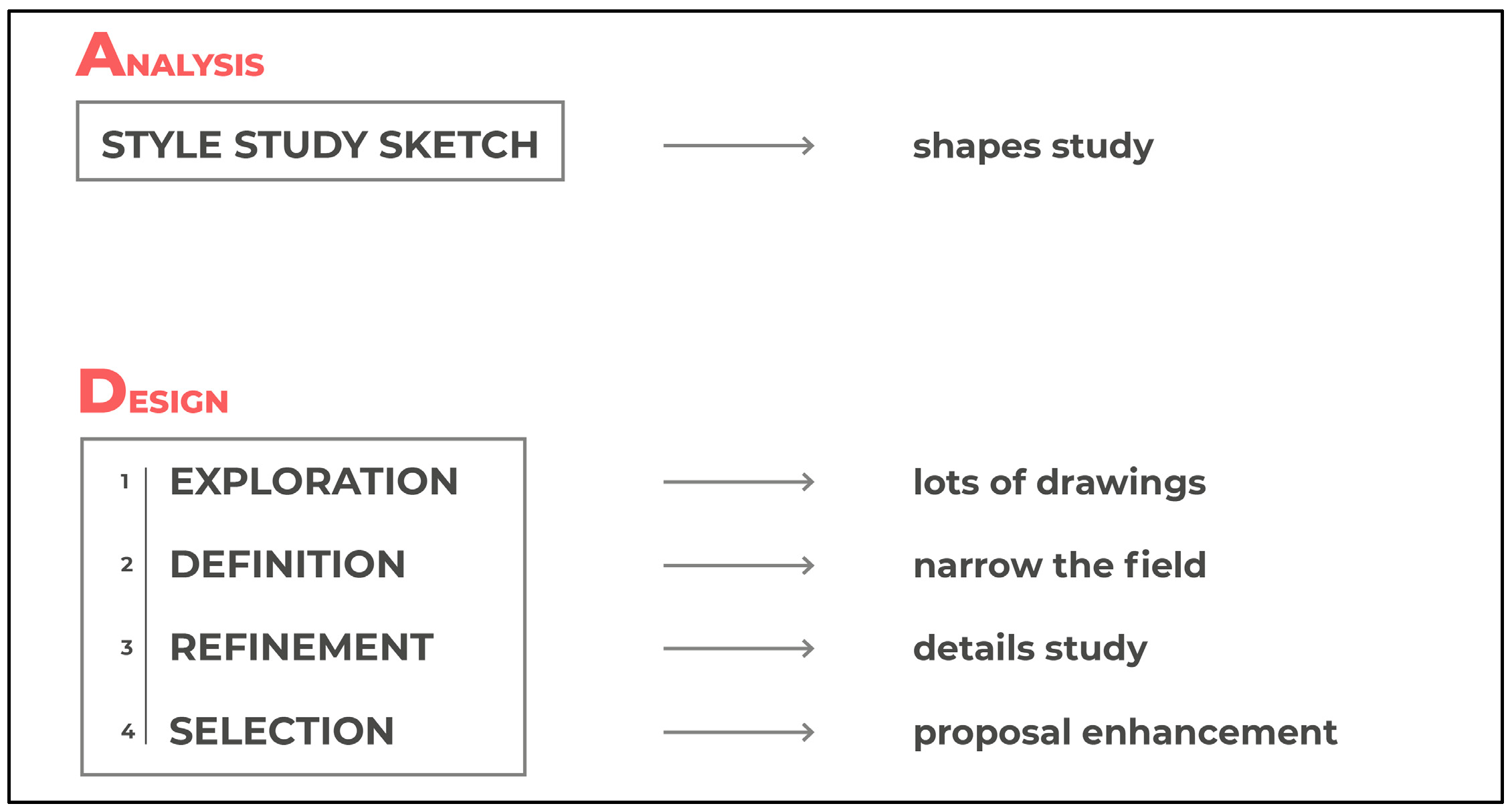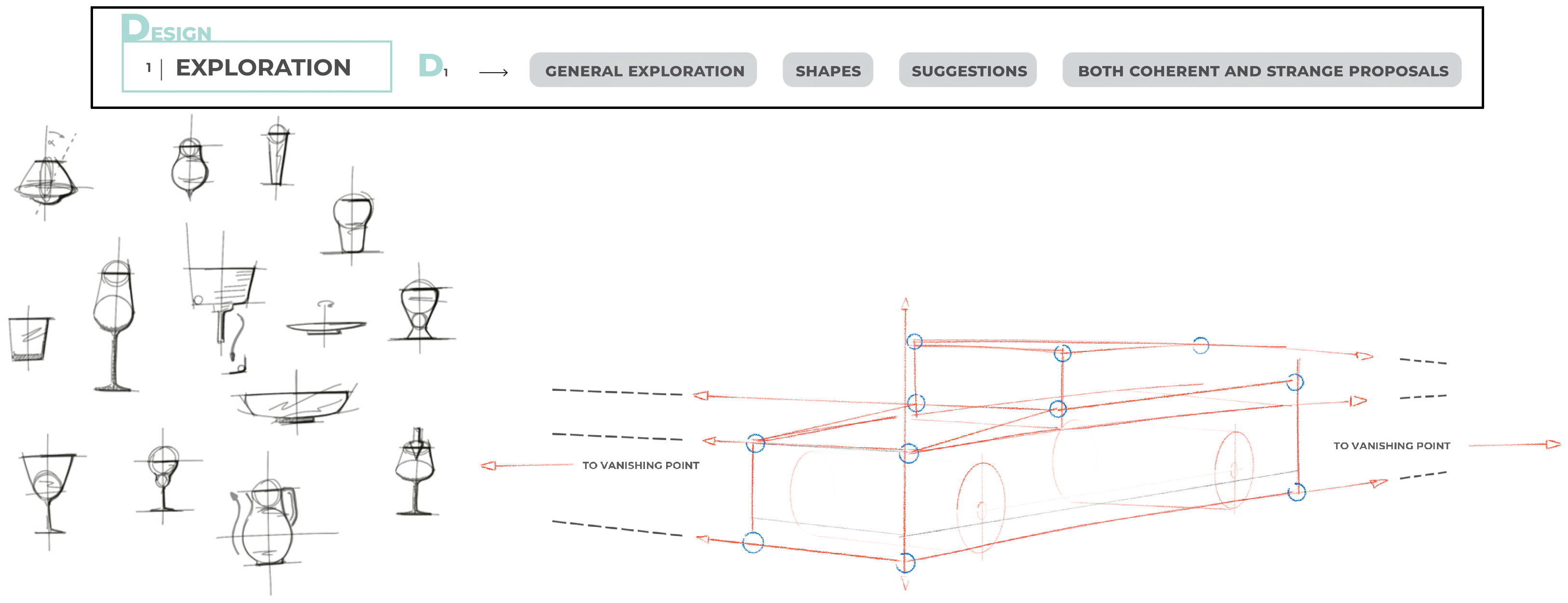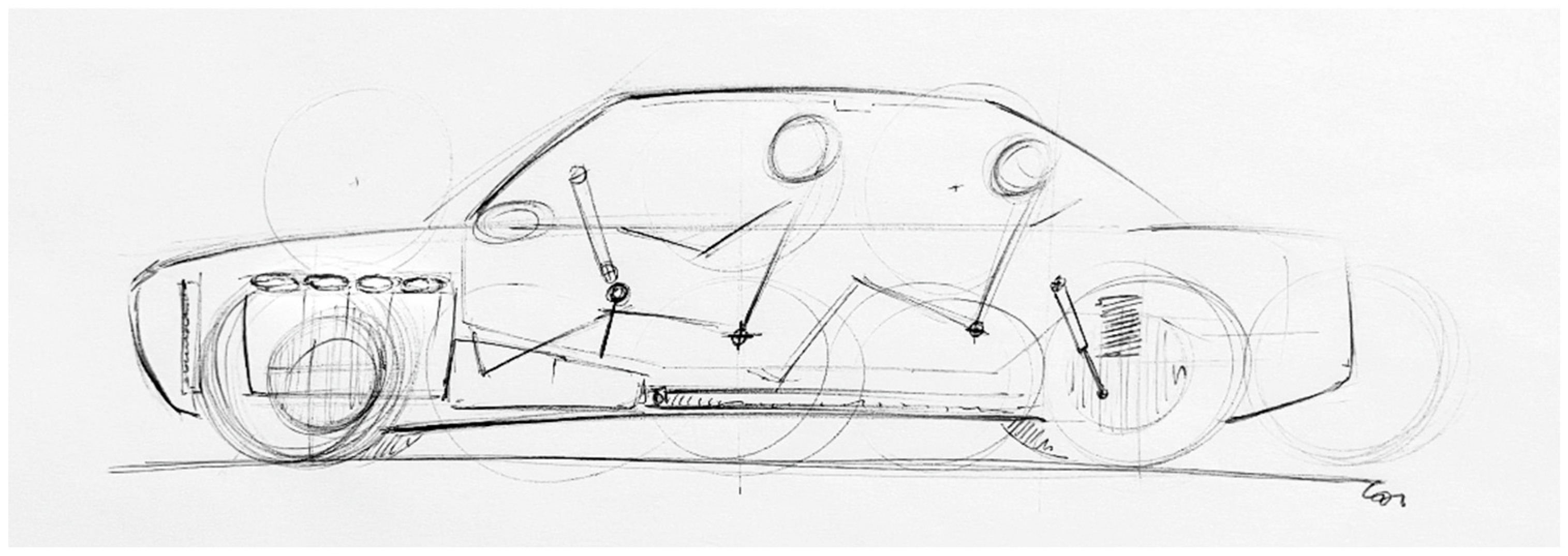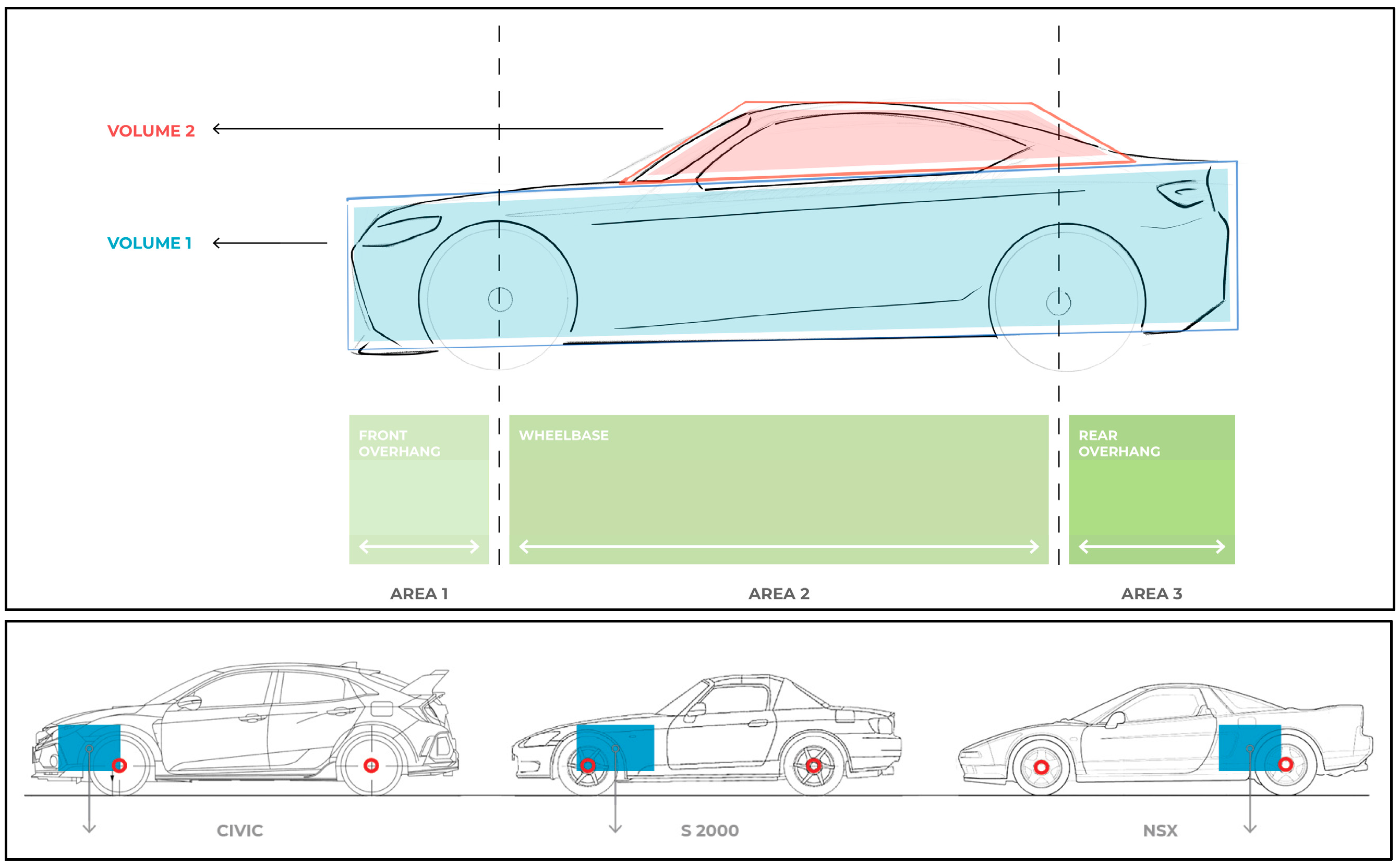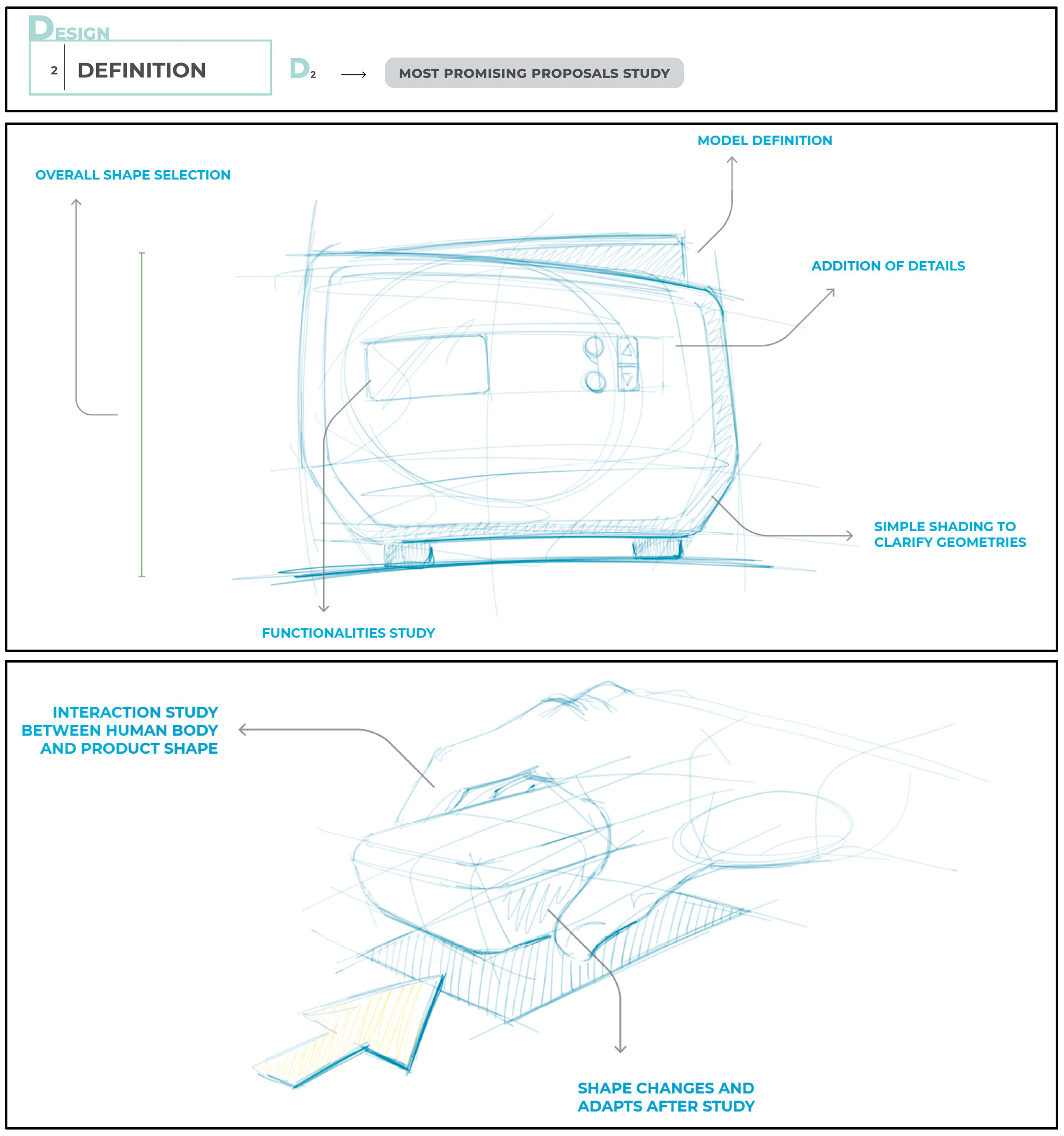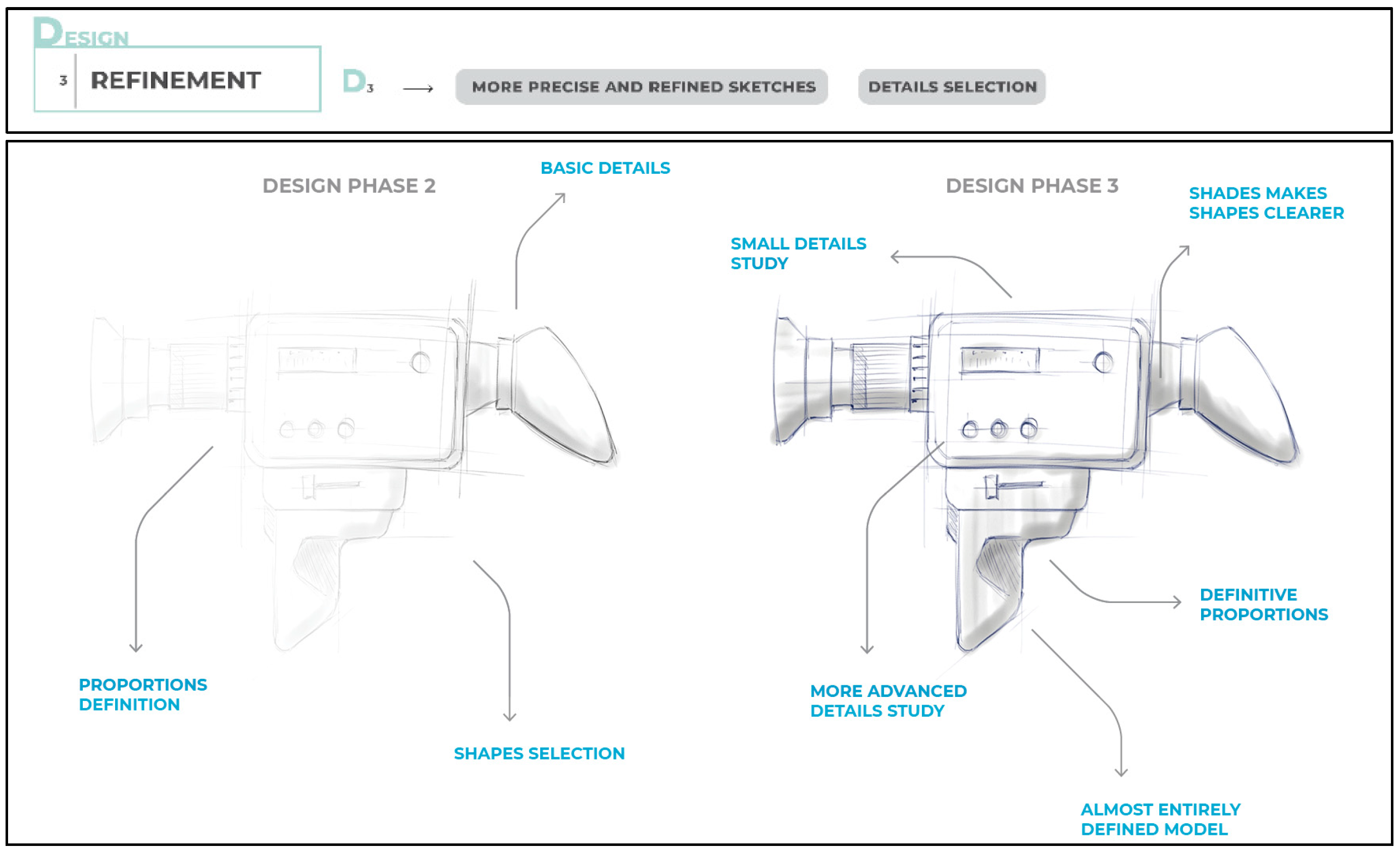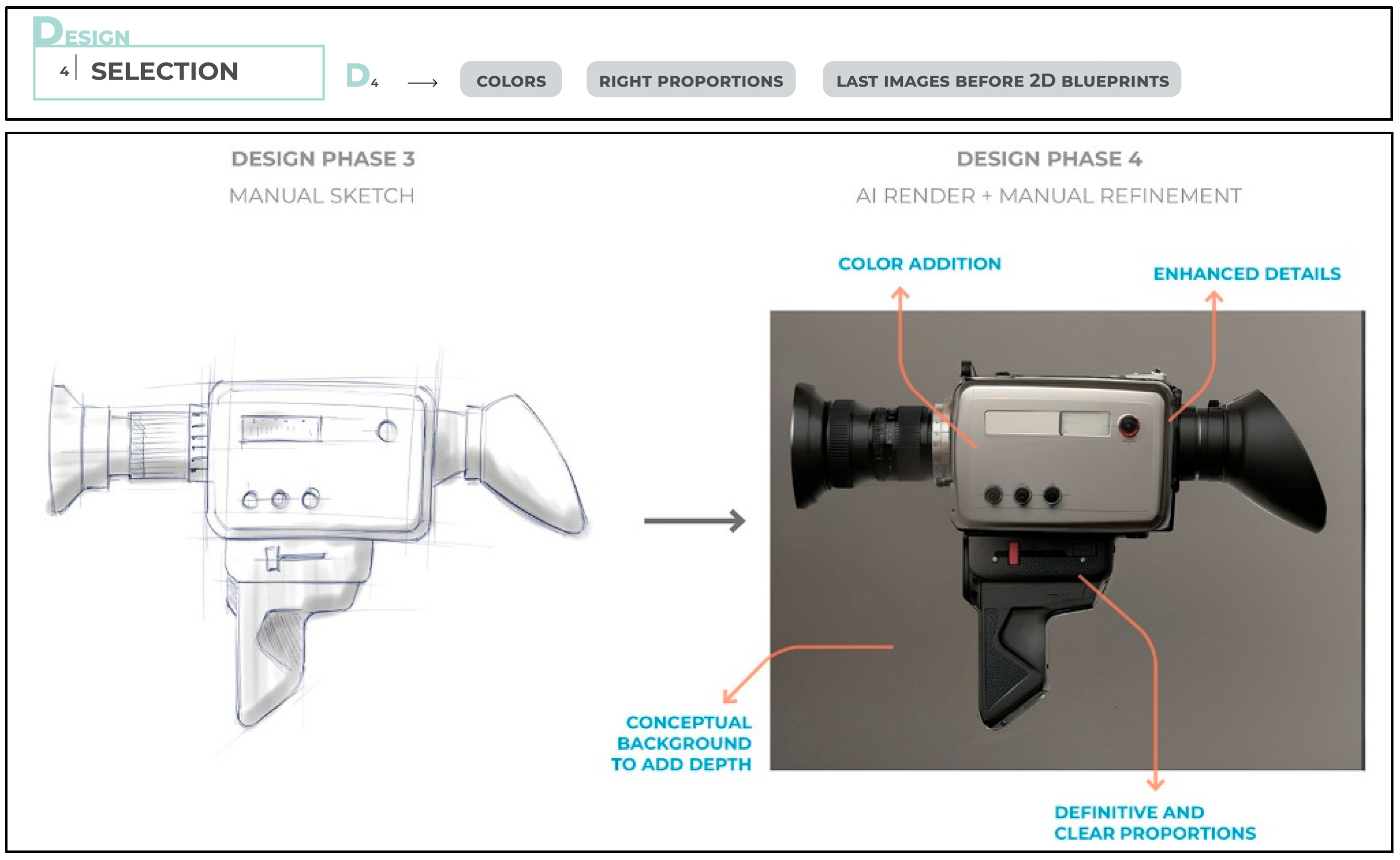1. Introduction
In design, particularly within the automotive sector, freehand sketching has historically been a cornerstone of the creative process. Despite its enduring role, its relevance has been the subject of debate over the years. While some highlight its foundational importance within traditional design processes, others question its continued effectiveness, viewing it as potentially obsolete in the face of integrated digital and AI-driven methodologies [
1,
2]. This paper revisits the role of sketching in modern design, exploring how it can coexist and thrive alongside technological innovations. Freehand sketching has traditionally served as a designer’s initial approach to defining and exploring forms. It follows immediately after research and analysis, functioning as a flexible tool for visualizing, evaluating, and refining concepts [
3,
4,
5]. During this phase, designers generate numerous ideas, many of which are discarded due to technical constraints, complexity, or incoherence. The iterative nature of sketching allows for quick identification of strengths and weaknesses, streamlining the workflow and fostering creative innovation [
6].
With the advent of digital sketching tools, such as graphic tablets and styluses, the traditional practice has evolved. These technologies offer the immediacy of freehand sketching while integrating seamlessly into digital workflows. The speed and flexibility afforded by these tools have transformed the design process, allowing for rapid iterations and enhanced precision [
7]. Digital sketching aligns naturally with subsequent design steps, including 2D drafting, 3D modeling, and simulation, which have been conducted digitally for decades [
8,
9]. Despite these advancements, traditional sketching retains unique advantages, particularly for beginners, as it fosters an intuitive understanding of form and technique that can later be transferred to digital tools [
10,
11].
In recent years, artificial intelligence (AI) has emerged as a transformative force in design. Generative AI tools can accelerate the ideation process by generating multiple design variants in seconds, analyzing stylistic trends, and proposing innovative solutions based on historical data [
1,
12]. This integration of AI with sketching facilitates a continuous feedback loop, enhancing both creative exploration and technical refinement [
13,
14,
15]. By combining traditional and digital sketching with AI capabilities, designers can achieve faster iterations, greater precision, and more reliable outcomes [
12,
16]. For experienced designers, sketching, whether analog or digital, remains an essential tool for capturing creative ideas and exploring innovative forms. However, for less experienced designers, sketching is even more critical, providing visual and physical support that compensates for gaps in expertise and fosters the development of high-quality concepts [
16,
17].
This study proposes a methodology that harmonizes traditional sketching, digital tools, and AI within the framework of Stylistic Design Engineering (SDE). The SDE methodology, originally developed for automotive concept development, structures the design process into sequential and iterative stages from style analysis to final validation. It integrates creative exploration with engineering feasibility by combining tools such as QFD, ergonomic assessment, and CAD modeling in a repeatable framework. By leveraging the structured, iterative approach of SDE, the paper aims to demonstrate how these tools can be integrated into a cohesive process that pre-serves creativity while enhancing efficiency and precision. In addition to its relevance to industrial and automotive design, the methodology aims to contribute to engineering design by supporting early-stage exploration of functional constraints, component integration, and user-centered technical solutions. The results highlight the potential of this integrated methodology to redefine automotive design, bridging the gap between tradition and innovation.
Literature Review
The role of sketching in the design process has been widely studied, yet few works specifically address its impact during the early stages of ideation and development [
18]. Research consistently highlights that increased reliance on sketching leads to improved design outcomes, as it supports critical activities such as analysis, communication, and documentation [
19]. Moreover, studies suggest a correlation between drawing proficiency and creativity, indicating that individuals skilled in sketching often exhibit heightened creative abilities. This has led to the hypothesis that training in sketching can actively foster creativity [
20]. Sketching can be divided into two primary categories: representational drawing and conceptual sketching. While the former focuses on capturing the likeness or abstraction of an object, the latter is a tool for ideation and problem-solving [
21]. Conceptual sketching is characterized by speed and effectiveness, allowing designers to “think on paper” and rapidly explore potential solutions (
Figure 1). Its accessibility makes it a vital tool for both experienced professionals and novices, democratizing the creative process regardless of individual talent.
With the advent of digital tools, the landscape of sketching has evolved significantly. Technologies like graphic tablets and styluses have introduced new possibilities, enabling seamless integration into digital workflows and enhancing the speed and precision of design iterations [
7,
22]. Digital sketching mirrors the progression of the overall design process, which has increasingly shifted to digital platforms for tasks like 3D modeling, rendering, and simulations [
8,
9]. Despite this shift, traditional analog sketching retains unique advantages, particularly in fostering intuitive and tactile engagement with ideas, an aspect especially beneficial for novice designers [
10,
11]. Recent advancements in artificial intelligence (AI) have added a new dimension to sketching. Generative AI models can quickly produce variations of sketches, analyze stylistic trends, and optimize designs based on historical data, offering unparalleled efficiency and creativity [
1,
12]. This integration allows for a synergistic feedback loop, where AI tools augment the creative process by generating and refining ideas in real-time [
13,
14,
15]. AI-assisted sketching tools have proven particularly useful in early ideation phases, enabling designers to explore diverse solutions while maintaining creative control (
Figure 2).
The interplay between sketching and AI raises important questions about representation quality and its impact on design perception. Kudrowitz and Wallace [
23] explored whether the clarity and visual quality of sketches influence how design ideas are received. Their findings suggest that representational quality can significantly affect the perception of creativity, underscoring the importance of balancing clarity with conceptual exploration. Kevin Henry’s seminal work, Drawing for Product Designers, further categorizes sketches into representational and functional tools, emphasizing the latter’s role in real-time ideation and refinement (
Figure 3).
To address the complexities of integrating traditional, digital, and AI-driven sketching, this study situates its theoretical framework within the Industrial Design Structure (IDeS) methodology. IDeS, which incorporates SDE and Quality Function Deployment (QFD), provides a comprehensive structure for innovation-driven design processes [
24]. SDE proves in particular to be invaluable in automotive and product design, as it bridges the gap between aesthetic exploration and technical feasibility (
Figure 4). Within this framework, sketching plays a dual role: as a creative tool in the early ideation phases and as a means of refining and aligning design proposals with technical constraints (
Figure 5 and
Figure 6).
Generative AI, when applied within the SDE methodology, offers numerous opportunities for innovation. For instance, AI can augment style analysis by generating design alternatives based on historical brand data, facilitate rapid conceptual sketching, and optimize 3D modeling workflows [
1,
15]. This integration enhances the efficiency and precision of the entire design process, reaffirming the importance of sketching as both a creative and practical tool in modern design.
2. Materials and Methods
The SDE method was chosen for this study because it provides a structured yet flexible framework that bridges creativity and technical feasibility, making it particularly suited to the complex demands of automotive design. SDE excels in guiding the transition from abstract ideas to fully developed proposals by balancing aesthetic exploration with rigorous methodological steps. The IDeS is a structured methodology for managing the design process, combining creative exploration with systematic evaluation across defined stages. Its focus is on aligning design outputs with technical feasibility, production requirements, and stakeholder needs. In contrast, SDE emphasizes the creative and aesthetic phases of design while integrating engineering constraints early in the process, facilitating concurrent refinement of style and function. Within this study, IDeS provides the overarching process framework, while SDE offers a style-centered pathway that naturally accommodates iterative AI-assisted ideation. This framework ensures that each phase of the design process, ranging from initial research and style analysis to sketching, modeling, and rendering, is systematically aligned with the brand identity and market expectations [
25]. By breaking down the process into manageable stages, SDE allows designers to iteratively refine their work while maintaining a coherent vision. Furthermore, its emphasis on integrating creative and technical considerations ensures that the final outcomes are not only innovative but also practical and market ready. Given its adaptability, SDE provides an ideal foundation for incorporating advanced tools such as generative AI. This integration enhances the exploratory nature of early design stages, optimizes the development of 3D models, and accelerates rendering processes, making SDE a powerful framework for uniting traditional sketching techniques with modern digital and AI-driven tools.
Generative AI models can be integrated into several stages of the SDE methodology to enhance efficiency and creativity. Specifically:
Style Analysis: AI can generate stylistic variations based on initial sketches and historical brand data, offering designers new perspectives and directions for exploration.
Sketching: By leveraging AI, conceptual sketches can be augmented with pro-posed shapes and ideas derived from basic inputs, accelerating the ideation process.
3D Modeling: AI can optimize the modeling phase by identifying structural and aesthetic improvements, streamlining the transition from conceptual de-signs to finalized models.
Rendering and AR: AI significantly enhances rendering workflows by optimizing materials, lighting, and textures, allowing for the creation of high-quality photorealistic images in less time.
The integration of generative AI within the SDE framework not only accelerates the design process but also enhances its iterative and exploratory nature, bridging the gap between creativity and technical precision. By embedding AI into critical stages, this methodology ensures that designers can produce innovative, stylistically coherent, and market-aligned outcomes with greater efficiency
2.1. AI-Assisted Design Implementation
The generative phase of the workflow was conducted using open-source tools: Stable Diffusion (SD) versions 1.5, XL, and Flux, operated via the Krita AI Diffusion plugin within the open-source raster painting software Krita 5.2.9 (under GPL-3.0 license). Advanced ControlNet features, such as depth, normals, style mapping, sketch guidance, and segmentation, were used to exert fine-grained control over image generation.
The image-to-image generation pipeline is structured into four sequential steps:
- a.
Input preprocessing
Sketches were preprocessed inside Krita: deskewing, normalization to 1024 × 1024, contrast enhancement, and optional binarization. When sketches included dense overlapping strokes, ControlNet-based edge or normal map guidance was used to clarify structure and simplify visual input.
- b.
Conditioned generation
Image-to-image sampling with classifier-free guidance was used. Parameters were: 25–50 diffusion steps, guidance scale between 7–9, and a fixed seed for reproducibility. The Krita plugin enabled seamless switching between SD v1.5, SD-XL, and Flux models depending on the desired stylistic output.
Prompts integrated high-level style cues with functional constraints (e.g., “maintain wheelbase and roofline”). ControlNet modules (depth, normal, style) were applied to guide generation toward structurally coherent outcomes.
- c.
Selection and post-processing
Each generation cycle produced batches of 8–12 variants. Selection combined automated filtering—using CLIP-based similarity metrics—and manual review to ensure preservation of proportions and design intent. Final images were refined in Krita and exported as vector outlines for CAD readiness.
- d.
Iterative human–AI loop
Designers reviewed AI outputs and fine-tuned prompts, ControlNet settings, or sketch input accordingly. This loop continued until outputs reached stylistic coherence thresholds (e.g., ≥4.5/5 in the expert panel).
Example prompts:
D1 (exploration): “Generate 10 compact city-car silhouettes from the sketch. Emphasize aerodynamic forms, strong shoulder lines, dynamic stance; respect wheelbase and roof height.” Step reinforced through ControlNets.
D2 (definition): “Produce refined side/front views with enhanced surface modeling and shading; focus on headlight and bumper articulation for a premium-compact identity.”
Control-based directive: “Use depth and normal map guidance to reinforce primary proportions and structural clarity.”
Negative prompt: “blurry, distorted-proportions, extra limbs, watermark, text”.
Pseudo-Algorithm
The main workflow of the proposed generative process is summarized in Algorithm 1.
| Algorithm 1. Generative loop for iterative sketch-to-model refinement |
Input: Raw sketch image → preprocessed via Krita + ControlNet (edge/depth).
Output: Vectorized sketch suitable for CAD integration. |
- 1.
InputSketch ← preprocess(raw_sketch via Krita + ControlNet edge/depth) - 2.
For iter = 1..Ncycles: - a.
Variants ← SD_image2image(InputSketch, Prompt, params, selected model + ControlNet maps) - b.
Filtered ← select(Variants via CLIP_similarity + manual_check) - c.
If Filtered meets acceptance criteria then break - d.
Else Adjust Prompt/InputSketch/ControlNet settings
- 3.
Postprocess(Filtered_best) → vector for CAD use
|
3. Results
Having established the theoretical foundation, we can now analyze the role and purpose of sketching within the design process, particularly through its integration with the SDE methodology. The SDE framework enables the systematic organization of design phases, utilizing free-hand drawing in distinct ways depending on the project stage. This structured approach provides clarity on when and how to deploy specific sketching techniques, ensuring that each phase is approached with the appropriate level of de-tail and focus.
Freehand drawing is most prominently featured in two critical phases of the SDE process: Style Analysis and Sketch (
Figure 7). These two phases, though interconnected, serve different purposes. In the Style Analysis phase, sketching is employed as an analytical tool to study and deconstruct the shapes, lines, and proportions of existing products as shown in
Figure 8. This activity, often referred to as the Style Study Sketch phase, involves tracing and examining the most defining features of a product to capture its stylistic essence and character. This phase not only supports the designer’s understanding of a product’s visual identity but also informs the development of new concepts that align with the brand’s heritage and market trends (
Figure 8).
The Sketch phase, in contrast, shifts from analysis to creation. Here, sketching becomes a tool for generating, refining, and selecting design proposals. This phase is divided into four stages (
Figure 9):
Exploration, where a wide range of creative ideas is generated without constraints.
Definition, where the most promising concepts are further developed with a focus on clarity and feasibility.
Refinement, where details are adjusted to ensure coherence and technical alignment.
Selection, where the final concept is chosen on its alignment with project goals and constraints (
Figure 9 and
Figure 10).
An important aspect of the design process lies in the interaction between these phases and the constraints that shape them (
Figure 11). Constraints are a fundamental element of SDE, influencing how sketches are created and utilized. These can be divided into two main categories: technical constraints and stylistic constraints.
Technical constraints often define the boundaries of feasibility and practicality. For instance, in automotive design, budget or engineering limitations may restrict interventions to specific areas, such as the redesign of bumpers and headlights, while leaving the main body panels untouched. Stylistic constraints, on the other hand, relate to the visual and conceptual aspects of a design. In a redesign project, these constraints may require continuity with the brand’s identity to retain customer familiarity or, conversely, may demand a disruptive approach to address issues associated with the previous model and reposition the product in the market [
26].
Understanding and addressing these constraints is essential to ensuring that the design process remains both innovative and aligned with project objectives. Freehand drawing, particularly in the Style Analysis and Sketch phases, serves as a critical tool for navigating these constraints. By enabling rapid exploration, visual analysis, and iterative refinement, sketching bridges the gap between creative freedom and the structured rigor of SDE. Through this integration, sketching is not only preserved as a vital part of the design workflow but also elevated in its role, ensuring that it remains relevant and effective in addressing the complexities of modern automotive design. During the development of Concept A, a key challenge emerged in reconciling the stylistic intent of a sloping roofline with minimum headroom requirements for the rear passengers. Initial AI-generated proposals tended to exaggerate the slope, compromising ergonomics. This issue was mitigated by introducing explicit geometric constraints into the prompts and applying ControlNet depth guidance to preserve target proportions. The revised workflow produced a balanced roofline while maintaining the intended sporty profile. This example illustrates how stylistic constraints (desired silhouette) and technical constraints (minimum headroom) directly guided prompt formulation, model selection, and filtering criteria, ultimately shaping the design outcome.
To contextualize the proposed methodology, a comparative assessment was conducted against a conventional sketch-to-CAD workflow without AI integration. In the case study, the traditional process required approximately 50 h from initial style analysis to final concept refinement, whereas the proposed SDE–AI integrated workflow achieved equivalent stylistic coherence in 36 h, representing a 28% reduction in development time. Additionally, the integrated approach produced a higher number of viable concept variants (15 in D1 and 5 in D2, compared to 9 and 3, respectively, in the traditional workflow), enabling a broader exploration of alternatives without extending project timelines (
Table 1). These results indicate that the proposed methodology improves both efficiency and design space exploration compared to standard practice.
3.1. Implications
3.1.1. The Role of Sketching Across the SDE Design Phases
This study has clarified the role and significance of sketching within the SDE framework, positioning it as a pivotal tool for navigating the complexities of modern design processes. By embedding freehand drawing into the structured phases of SDE, designers can systematically address different project requirements, leveraging sketching as both an analytical and creative instrument. Each stage in the process benefits from tailored sketching techniques, ensuring that every step aligns with the overarching design goals.
Within the SDE framework, the sketching process is concentrated in two key phases: Style Study Sketch (A1) and Sketch Development (D1–D4). These phases, while distinct in purpose, complement each other by transitioning from analysis to creative exploration.
Style Study Sketch (A1): Analytical Foundations
The Style Study Sketch phase is inherently analytical, focusing on deconstructing and studying the lines, proportions, and details of existing products (
Figure 12 and
Figure 13). This phase is critical for capturing the visual essence and stylistic DNA of a design, especially in industries like automotive design, where heritage and continuity play significant roles.
By tracing and analyzing the key features of a product, designers gain a deeper understanding of its aesthetic and functional characteristics. This analysis not only informs new concepts but also ensures consistency with brand identity and market expectations (
Figure 13). Key aspects of this phase include identifying shapes, proportions, and defining lines that characterize the product. The outcome of this analysis provides a solid foundation for the creative phases that follow, linking past designs to future innovations while maintaining a coherent stylistic trajectory.
3.1.2. Sketch Development (D1–D4): From Ideation to Refinement
Following the analytical groundwork, the Sketch Development phase shifts to creating and refining design proposals. This phase unfolds over four iterative stages:
Exploration (D1)
At this stage, designers focus on generating a broad range of creative ideas without committing to a specific direction. Freehand sketching provides the flexibility to experiment with unconventional forms, proportions, and configurations, enabling designers to explore solutions beyond conventional boundaries. Techniques such as the use of geometric “holding boxes” help establish basic proportions and simplify the design process by offering a framework for rapid iterations (
Figure 14).
At this stage, to effectively explore and define proportions, employing specific drawing techniques can be highly beneficial for achieving organic and proportionate forms. These techniques facilitate the initial study of shapes and provide a foundation for subsequent design steps. One commonly used method is the creation of “holding boxes,” which act as reference frameworks for designing final shapes. This approach is widely applicable in both product design and automotive contexts, as it simplifies the design process by offering clear geometric guidelines. Strategic placement of these geometric shapes, or their subdivisions, helps efficiently manage complex forms by providing key height references, such as those between the wheels, roofline, and wheelbase of a vehicle (
Figure 15).
In addition to its practical advantages for manual sketching, this simplified approach also has significant implications for the integration of artificial intelligence (AI) in the design process. Clear and well-structured sketches, such as those based on holding boxes, provide AI algorithms with an ideal starting point for image interpretation and processing. The geometric regularity and defined proportions act as a guide for AI, improving its ability to generate accurate design variations and maintain consistency with the intended forms.
However, this method presents potential challenges. The use of multiple lines, while beneficial for establishing precise proportions, can sometimes confuse AI systems, especially when there is an overabundance of intersecting or overlap-ping elements. This creates a trade-off: while the geometric structure aids AI in understanding the overall design framework, excessive complexity in linework may reduce the clarity of input data.
To optimize AI performance, it is essential to find a balance in sketch complexity. AI tends to perform best when sketches feature a moderate number of lines, high contrast, and clear separation between key elements (
Figure 16). Simplifying the sketch without compromising its structural integrity can improve AI interpretation while maintaining the benefits of manual exploration. This balance ensures that both the designer and the AI can work synergistically, with sketches serving as a bridge between human creativity and computational efficiency.
Definition (D2)
Here, the most promising ideas from the exploration stage are refined and evaluated against project criteria, such as technical feasibility, innovation, budget constraints, and target audience expectations. Sketches created during this phase strike a balance between conceptual flexibility and detailed representation, laying the groundwork for further refinement. During this phase, sketches are created for the top 2–3 ideas, incorporating a higher level of detail than in the initial exploration phase (
Figure 17). While these sketches remain conceptual, they provide a more precise representation of the selected models, allowing for flexibility and further modifications.
The rigid and objective structure of the sketch greatly aids generative AI, which can already be successfully applied at this stage (
Figure 18). It is particularly important to note that the style remains consistent with the design lines established through freehand sketching. For this sketch, Stable Diffusion 1.5 was used.
Refinement (D3)
In the Refinement phase (D3), the focus shifts to enhancing the selected concepts, bringing them closer to a final design. This involves establishing fixed elements and conducting further exploration to optimize design solutions for each component. The phase transitions from conceptual to tangible design, refining details, finishes, materials, and specific component shapes (
Figure 19).
The aim is to develop an almost finalized product version, based on comprehensive research and design work. Sketches become more detailed, incorporating elements like sections, exploded views, and shading to enhance the perception of depth and realism (
Figure 20). This phase bridges the gap between conceptual design and tangible prototypes, ensuring alignment with both functional and aesthetic goals.
Selection (D4)
The final phase, Selection, involves finalizing the freehand sketches before transitioning to detailed blueprint creation. In this phase, all unresolved issues are addressed to produce a detailed, feasible proposal aligned with the project brief and constraints (
Figure 21 and
Figure 22). Although perfection is not the focus, sketches should facilitate clear communication of the product’s characteristics.
This phase ensures a comprehensive understanding of the product and sets the stage for precise blueprint development. In the example shown here, enhanced by the added depth, the sketch effectively communicates the product’s concepts and proportions, making it accessible even to those outside the automotive field. This phase ensures a comprehensive understanding of the product and sets the stage for precise blueprint development. In the example shown here, enhanced by the added depth, the sketch effectively communicates the product’s concepts and proportions, making it accessible even to those outside the automotive field.
The sketching process, while detailed, is intended as a preliminary design tool distinct from the final representative drawings. This “work in progress” state is advantageous, allowing for flexibility in revisions and facilitating ongoing client consultations for final adjustments and design approval. The methodology involves multiple phases, each adding complexity and detail to the sketches. However, moving from one phase to another (D1, D2, etc.) requires significant time investment. While it is beneficial to develop highly detailed sketches, especially when using AI, which performs better with more data, it is crucial to find a balance. Starting the AI integration phase too late can result in lost time, as detailed sketches require considerable effort. Thus, the challenge lies in determining the optimal point to transition from manual sketching to digital enhancement. The accompanying image demonstrates the four distinct phases applied to the same product, showcasing the process’s effectiveness. The use of color in these sketches enhances depth and realism, facilitating better comprehension. The final sketches, featuring various views, are prepared for presentation as a summary of the concept phase, ready for subsequent digital modeling and refinement.
3.1.3. The Role of Constraints in Sketching
Throughout these phases, technical and stylistic constraints play a critical role in shaping the sketching process. In the design environment, technical constraints such as engine placement or drivetrain configuration influence the proportions and layout of the vehicle. Stylistic constraints, on the other hand, guide the design’s aesthetic direction, whether through continuity with a brand’s existing identity or a disruptive approach to redefine its image [
26].
Sketching provides a flexible medium for navigating these constraints, allowing designers to explore solutions that balance creative freedom with practical limitations. For example, repetitive use of geometric shapes like circles and squares can streamline the exploration of vehicle proportions, while more complex shapes enable faster transitions to refined designs (
Figure 14 and
Figure 18).
3.1.4. AI Integration in Sketching
Generative AI further enhances the effectiveness of sketching, particularly in the exploratory and analytical phases. During Exploration (D1), AI can assist by generating multiple design variations based on initial sketches and predefined constraints, broadening the scope of possibilities. In the Style Study Sketch phase (A1), AI can analyze historical design data to provide insights and generate stylistically coherent sketches, accelerating the analytical process. As the design progresses, AI plays a supportive role in refining details and optimizing proportions, particularly in the Definition (D2) and Refinement (D3) phases. However, the effectiveness of AI relies on the quality of input sketches. Insufficiently detailed sketches can lead to inconsistencies, as AI may generate forms that lack alignment with the intended design direction (
Figure 22).
3.1.5. Bridging Manual and Digital Processes
The integration of sketching within SDE emphasizes its role as a dynamic and iterative tool, bridging manual and digital processes. By transitioning from free-hand sketches to detailed digital models, designers can maintain the intuitive creativity of traditional techniques while leveraging the precision and efficiency of modern technologies. This synergy ensures that sketching remains a vital component of the design process, adaptable to the demands of contemporary innovation.
4. Discussion
The integration of sketching, digital tools, and artificial intelligence within the SDE framework presents both opportunities and challenges for the evolution of contemporary design practices. From an engineering design perspective, the phased integration of sketching and AI provides a structured means to balance creative expression with functional performance, enabling more informed decisions in complex product development. The findings of this study underscore the feasibility of aligning traditional freehand techniques with computational tools, fostering a hybrid workflow that retains the creative intuition of sketching while harnessing the speed and adaptability of generative AI. A core insight emerging from the results is the pivotal role of structured phase delineation. The subdivision of the sketching process into distinct, goal-oriented stages (A1, D1–D4) enables designers to apply appropriate cognitive and technical strategies at each step. This methodological rigor enhances both the traceability of design decisions and the reproducibility of the process, two aspects often underrepresented in early-stage design methods.
These findings align with and expand upon prior literature highlighting the generative and iterative nature of sketching in industrial design. As emphasized by Lou et al. [
19] and Kudrowitz et al. [
21], sketching supports ideation and evaluation, but our study adds a procedural dimension through the application of SDE. Furthermore, our results reinforce the perspective of Zhang et al. [
8], who explored the potential of AI-enhanced sketch interpretation, showing how AI can broaden design variation and accelerate stylistic exploration, provided input clarity is maintained.
The proposed method can be integrated into design education by using AI-assisted ideation as a complement to traditional sketching courses. Students can explore multiple stylistic directions in compressed timeframes, compare AI outputs with their original intent, and iteratively refine prompts to improve both conceptual clarity and technical awareness.
The implementation of AI tools within the sketching process corroborates recent research on machine–human co-creativity [
14,
15], yet it also exposes limitations. Generative systems exhibit high dependency on the quality of sketch input. Overly complex or ambiguous linework can lead to semantic drift and loss of stylistic coherence, echoing concerns raised in prior studies. These findings validate our initial working hypothesis: AI can enhance, but not replace, sketch-based ideation, and its integration is most effective when constrained by a structured methodology [
26].
Beyond its dependency on input sketch quality, the AI process remains sensitive to dataset bias, which can subtly influence stylistic tendencies, and to inherent stochasticity in generative models, occasionally producing outliers even with fixed seeds. These limitations require active human oversight to ensure that outputs remain aligned with the intended brand identity and functional requirements.
From a broader perspective, this research contributes to reframing sketching as a transitional medium between analog and digital workflows. It challenges the binary view of traditional vs. computational design, proposing instead a spectrum where human intuition and machine precision coexist and reinforce each other. This has significant implications for design education, where sketching is often taught as a standalone manual skill rather than as part of a holistic workflow.
The method facilitates interdisciplinary collaboration as well by providing visual outputs that can be rapidly shared with engineers, ergonomists, and marketing teams. Technical teams can flag feasibility issues early, while marketing can test aesthetic concepts with target audiences before committing to physical prototyping.
Nevertheless, generalizability remains a limitation. The workflow was tested in a controlled academic context with experienced designers. Its applicability to team-based or time-constrained industrial settings needs further exploration. Moreover, the AI tools used were general-purpose and not yet specifically trained on automotive data, which may limit stylistic consistency in professional environments. User testing and market validation steps can be incorporated by subjecting AI-generated concepts to targeted surveys or A/B testing with representative user groups. Feedback scores on aesthetics, perceived functionality, and brand fit can be fed back into the iterative loop to guide further refinements.
Future research should investigate:
The scalability of the method in collaborative settings;
The usability of AI-assisted sketching tools for novice designers;
The development of custom-trained AI models for specific design languages or brand identities;
The potential to integrate this workflow with VR/AR sketching environments and real-time design reviews.
Ultimately, this study advances a vision of design sketching as both a cognitive tool and a technological interface, bridging the gap between creative ideation and structured execution. As design practices continue to evolve, embracing hybrid workflows like the one proposed here will be crucial to sustaining both innovation and methodological robustness.
5. Conclusions
This study has proposed a structured sketching methodology grounded in the Stylistic Design Engineering framework, demonstrating how traditional hand drawing, digital tools, and generative AI can be effectively integrated into a unified design process. By articulating the sketching workflow into distinct phases, ranging from stylistic analysis to concept refinement, the method enables designers to balance creative freedom with technical constraints in a repeatable and scalable way. One of the central contributions of this research lies in reframing sketching as a systematic design tool rather than a purely intuitive practice. The integration of AI, particularly in the early ideation and refinement stages, enhances the exploratory potential of sketching and accelerates design iteration. Rather than replacing the designer, AI serves as a co-creative agent, augmenting both the speed and depth of visual exploration. That said, the study also highlights important practical challenges, notably the sensitivity of AI to input quality. The effectiveness of AI tools is closely tied to the clarity, structure, and semantic readability of sketches, reinforcing the need for careful planning in the transition from manual drawing to digital enhancement.
The integration of sketching and AI within the SDE framework also serves as a valuable asset for engineering design, particularly in aligning conceptual exploration with functional and technical requirements early in the development cycle.
Looking ahead, the next step will be to apply and test this methodology across real-world case studies and collaborative design environments. Doing so will help validate its scalability, identify context-specific adaptations, and refine the process for broader adoption in both educational and industrial settings.
Future research will explore integration with parametric CAD environments for direct geometry generation, automated prompt optimization using reinforcement learning, and structured user testing protocols. Expected challenges include bridging the gap between image outputs and manufacturable geometry, and mitigating AI bias in stylistic interpretation.
Ultimately, this research supports the idea that sketching, far from being obsolete, is evolving into a more versatile and technologically integrated practice. The synergy between human creativity and computational assistance offers new possibilities for designers to navigate complexity, shorten development cycles, and deliver more innovative and coherent design outcomes.
Author Contributions
Conceptualization, G.G. and G.D.; methodology, L.F. and G.D.; software, G.G.; validation, G.D. and L.F.; formal analysis, G.G.; investigation, G.G. and G.D.; resources, L.F.; data curation, G.G. and G.D.; writing—original draft preparation, G.G.; writing—review and editing, G.G. and G.D.; visualization, G.G.; supervision, G.D.; project administration, G.D. and L.F.; funding acquisition, not applicable. All authors have read and agreed to the published version of the manuscript.
Funding
This research received no external funding.
Data Availability Statement
This research is based on conceptual and methodological development carried out during the authors’ doctoral and academic activities. It includes references to internal student works and previous teaching materials. The original contributions presented in this study are included in the article. Further inquiries can be directed to the corresponding author.
Acknowledgments
The authors would like to thank the students and colleagues involved in the earlier academic activities and design workshops that inspired the development of this methodology. During the preparation of this manuscript, the authors used ChatGPT (OpenAI, GPT-4, 2025) for language editing and text refinement. The authors have reviewed and edited the AI-generated content and take full responsibility for the final text. Additionally, Stable Diffusion (v1.5) was used to support visual sketch augmentation during the ideation and refinement phases. The resulting images were curated and integrated into the methodology as illustrative examples.
Conflicts of Interest
The authors declare no conflicts of interest.
Abbreviations
| AI | Artificial Intelligence |
| AR | Augmented Reality |
| CAD | Computer-Aided Design |
| IDeS | Industrial Design Structure |
| QFD | Quality Function Deployment |
| SDE | Stylistic Design Engineering |
| VR | Virtual Reality |
References
- Li, P.; Li, B.; Li, Z. Sketch-to-architecture: Generative AI-aided architectural design. arXiv 2024, arXiv:2403.20186. [Google Scholar]
- Zhou, Y.; Park, H.J. An AI-augmented multimodal application for sketching out conceptual design. Int. J. Archit. Comput. 2023, 21, 565–580. [Google Scholar] [CrossRef]
- Nuere, S.; Ruiz Gómez, M.E.; de Miguel Álvarez, L. Sketch as a Tool of Thought in Art and Science. In Proceedings of the 80th International Scientific Conference of the University of Latvia, Riga, Latvia, 11 February 2022. [Google Scholar]
- Jeong, S. Case study: Effectiveness of a sketch learning model for engineering students. J. Mech. Sci. Technol. 2019, 33, 5721–5730. [Google Scholar] [CrossRef]
- Heideman, P.D.; Flores, K.A.; Sevier, L.M.; Trouton, K.E. Effectiveness and adoption of a drawing-to-learn study tool for recall and problem solving: Minute sketches with folded lists. CBE—Life Sci. Educ. 2017, 16, ar28. [Google Scholar] [CrossRef] [PubMed]
- Bhargava, R.; Williams, D.; D’Ignazio, C. How learners sketch data stories. In Proceedings of the 2021 IEEE Visualization Conference (VIS), New Orleans, LA, USA, 24–29 October 2021; IEEE: Piscataway, NJ, USA, 2021; pp. 196–200. [Google Scholar]
- Bartlett, K.A.; Camba, J.D. Generative artificial intelligence in product design education: Navigating concerns of originality and ethics. Int. J. Interact. Multimedia Artif. Intell. 2024, 8, 55–64. [Google Scholar] [CrossRef]
- Zhang, W.; Ranscombe, C.; Radcliffe, D.; Jackson, S. Creation of a Framework of Design Tool Characteristics to Support Evaluation and Selection of Visualisation Tools. Proc. Des. Soc. Int. Conf. Eng. Des. 2019, 1, 1115–1124. [Google Scholar] [CrossRef]
- Leake, J.M.; Goldstein, M.H. Engineering Design Graphics: Sketching, Modeling, and Visualization; John Wiley & Sons: Hoboken, NJ, USA, 2022. [Google Scholar]
- Kumar, P. Sculpting with Algorithms: A Computational Approach to Analyzing Digital and Traditional Methods. In Proceedings of the 2024 IEEE 16th International Conference on Computational Intelligence and Communication Networks (CICN), Indore, India, 22–23 December 2024; IEEE: Piscataway, NJ, USA, 2024; pp. 1157–1161. [Google Scholar]
- Ranscombe, C.; Zhang, W.; Rodda, J.; Mathias, D. Digital Sketch Modelling: Proposing a Hybrid Visualisation Tool Combining Affordances of Sketching and CAD. Proc. Des. Soc. Int. Conf. Eng. Des. 2019, 1, 309–318. [Google Scholar] [CrossRef]
- Wang, W.; Pangaro, P.; Martelaro, N.; Byrne, D. Generative image AI using design sketches as input: Opportunities and challenges. In Proceedings of the 15th Conference on Creativity and Cognition, New York, NY, USA, 19–21 June 2023; pp. 254–261. [Google Scholar]
- Tholander, J.; Jonsson, M. Design ideation with AI-sketching, thinking and talking with generative machine learning models. In Proceedings of the 2023 ACM Designing Interactive Systems Conference, Pittsburgh, PA, USA, 10–14 July 2023; pp. 1930–1940. [Google Scholar]
- Baudoux, G. The benefits and challenges of AI image generators for architectural ideation: Study of an alternative human-machine co-creation exchange based on sketch recognition. Int. J. Arch. Comput. 2024, 22, 201–215. [Google Scholar]
- Koley, S.; Bhunia, A.K.; Sekhri, D.; Sain, A.; Chowdhury, P.N.; Xiang, T.; Song, Y.Z. It’s All About Your Sketch: Democratising Sketch Control in Diffusion Models. In Proceedings of the IEEE/CVF Conference on Computer Vision and Pattern Recognition, Seattle, WA, USA, 16–22 June 2024; pp. 7204–7214. [Google Scholar]
- Bilda, Z.; Gero, J.S.; Purcell, T. To sketch or not to sketch? That is the question. Des. Stud. 2006, 27, 587–613. [Google Scholar] [CrossRef]
- Kwon, J.; Kudrowitz, B. Good idea! Or, good presentation? Examining the effect of presentation on perceived quality of concepts. Artif. Intell. Eng. Des. Anal. Manuf. 2018, 32, 380–389. [Google Scholar] [CrossRef]
- Yıldızoğlu, N. Sketching Versus Digital Design Tools in Architectural Design. J. Comput. Des. 2024, 5, 301–316. [Google Scholar] [CrossRef]
- Lou, Q.; Bai, Y.; Ying, H.; Cai, L.; Feng, X.; Zhang, X. Collaborative Sketching: Human-AI Collaboration Modes for Enhancing Designers’ Performance and Experience in Sketching. In Proceedings of the 2024 17th International Symposium on Computational Intelligence and Design (ISCID), Hangzhou, China, 14–15 December 2024; IEEE: Piscataway, NJ, USA, 2024; pp. 159–162. [Google Scholar]
- Chan, D.W.; Zhao, Y. The Relationship Between Drawing Skill and Artistic Creativity: Do Age and Artistic Involvement Make a Difference? Creativity Res. J. 2010, 22, 27–36. [Google Scholar] [CrossRef]
- Kudrowitz, B.; Te, P.; Wallace, D. The influence of sketch quality on perception of product-idea creativity. Artif. Intell. Eng. Des. Anal. Manuf. 2012, 26, 267–279. [Google Scholar] [CrossRef]
- Donnici, G.; Frizziero, L.; Liverani, A.; Buscaroli, G.; Raimondo, L.; Saponaro, E.; Venditti, G. A New Car Concept Developed with Stylistic Design Engineering (SDE). Inventions 2020, 5, 30. [Google Scholar] [CrossRef]
- Frizziero, L.; Donnici, G.; Francia, D.; Caligiana, G.; Gaddoni, A. Stylistic design engineering (SDE) for an innovative green vehicle following QFD and triz applications. Int. J. Mech. Prod. Eng. Res. Dev. 2019, 9, 805–827. [Google Scholar] [CrossRef]
- Kim, Y. Design Constraints Adopted by Industrial Design Students in the Concept Design Phase. Arch. Des. Res. 2014, 27, 199–213. [Google Scholar] [CrossRef]
- da Silva, A.M. In a Digital/Artificial Intelligence time can sketches still be useful for Design Process? In Proceedings of the Human Systems Engineering and Design (IHSED 2023): Future Trends and Applications, Dubrovnik, Croatia, 27–29 September 2023; AHFE Open Access: İstanbul, Türkiye, 2023; Volume 112, p. 112. [Google Scholar]
- Sreenivasan, A.; Suresh, M. Design thinking and artificial intelligence: A systematic literature review exploring synergies. Int. J. Innov. Stud. 2024, 8, 297–312. [Google Scholar] [CrossRef]
Figure 1.
Description of sketching characteristics according to “Kevin Henry”. Drawing for Product Designers.
Figure 1.
Description of sketching characteristics according to “Kevin Henry”. Drawing for Product Designers.
Figure 2.
Example of a simple drawing. This technique, while good for representation and communication, is not as useful in the design path (left). Scale of importance represented with a graphical example (right).
Figure 2.
Example of a simple drawing. This technique, while good for representation and communication, is not as useful in the design path (left). Scale of importance represented with a graphical example (right).
Figure 3.
Scale of importance represented with a graphical example.
Figure 3.
Scale of importance represented with a graphical example.
Figure 4.
The IDeS scheme (left); Summary of a design path using QFD and SDE (right).
Figure 4.
The IDeS scheme (left); Summary of a design path using QFD and SDE (right).
Figure 5.
Components of QFD and SDE methods.
Figure 5.
Components of QFD and SDE methods.
Figure 6.
SDE design path with all the various steps put in a chronological order.
Figure 6.
SDE design path with all the various steps put in a chronological order.
Figure 7.
Phases in which freehand drawings are involved: Style Analysis and Sketch.
Figure 7.
Phases in which freehand drawings are involved: Style Analysis and Sketch.
Figure 8.
Example of Style Study Analysis applied to the back part of a car side view (left); Shapes and details study using product images as references. At this point it is possible to imagine and draw lines coherent with the product studied (right).
Figure 8.
Example of Style Study Analysis applied to the back part of a car side view (left); Shapes and details study using product images as references. At this point it is possible to imagine and draw lines coherent with the product studied (right).
Figure 9.
Different kinds of sketches involved.
Figure 9.
Different kinds of sketches involved.
Figure 10.
Various sketch forms inside the design path.
Figure 10.
Various sketch forms inside the design path.
Figure 11.
The role of constraints inside the SDE design path.
Figure 11.
The role of constraints inside the SDE design path.
Figure 12.
Key words related to the Style Study Sketch phase (top); Key words related to the design sketch phases (bottom).
Figure 12.
Key words related to the Style Study Sketch phase (top); Key words related to the design sketch phases (bottom).
Figure 13.
All the steps inside the Style Analysis phase.
Figure 13.
All the steps inside the Style Analysis phase.
Figure 14.
Key words related to the D1 phase (top); Multiple sketches of simple shapes to define the general ideas (bottom left); D1 phase applied to our case study car sketch. Creation of general proportions and shapes (bottom right).
Figure 14.
Key words related to the D1 phase (top); Multiple sketches of simple shapes to define the general ideas (bottom left); D1 phase applied to our case study car sketch. Creation of general proportions and shapes (bottom right).
Figure 15.
Simple car sketch using box and circles repetition to create references for the shape. Simple mechanical elements were added to introduce some basic technical constraints.
Figure 15.
Simple car sketch using box and circles repetition to create references for the shape. Simple mechanical elements were added to introduce some basic technical constraints.
Figure 16.
Key aspects that heavily affect cars proportions: key volumes to define proportions (top) and different engine positionings on FF, FR and MR cars (bottom).
Figure 16.
Key aspects that heavily affect cars proportions: key volumes to define proportions (top) and different engine positionings on FF, FR and MR cars (bottom).
Figure 17.
Key concept related to the D2 phase (top); Details and ergonomics study on D2 phase sketch (middle, bottom).
Figure 17.
Key concept related to the D2 phase (top); Details and ergonomics study on D2 phase sketch (middle, bottom).
Figure 18.
D1 (left) and D2 (right) phases on our car case study.
Figure 18.
D1 (left) and D2 (right) phases on our car case study.
Figure 19.
Key words related to the D3 phase (top); D3 phase sketch (bottom). Details are gradually added to reflect a deepened study, with refined shapes and added details that clearly convey the product concept.
Figure 19.
Key words related to the D3 phase (top); D3 phase sketch (bottom). Details are gradually added to reflect a deepened study, with refined shapes and added details that clearly convey the product concept.
Figure 20.
Car case study in D3 phase.
Figure 20.
Car case study in D3 phase.
Figure 21.
Key words of the D4 phase (top); detailed yet conceptual sketch inside D4 phase (bottom).
Figure 21.
Key words of the D4 phase (top); detailed yet conceptual sketch inside D4 phase (bottom).
Figure 22.
The final sketch incorporates color to enhance depth and detail, and its AI-refined version.
Figure 22.
The final sketch incorporates color to enhance depth and detail, and its AI-refined version.
Table 1.
Comparison between the proposed SDE–AI integrated workflow and a traditional sketch-to-CAD process. * Based on evaluation by a panel of three experienced automotive designers.
Table 1.
Comparison between the proposed SDE–AI integrated workflow and a traditional sketch-to-CAD process. * Based on evaluation by a panel of three experienced automotive designers.
| Metric | Traditional Workflow | SDE–AI Workflow | Improvement |
|---|
| Total time from style analysis to final sketch | 50 h | 36 h | −28% |
Concept variants
generated in D1 | 9 | 15 | +67% |
Concept variants
generated in D2 | 3 | 5 | +67% |
Average stylistic
coherence rating * | 4.3/5 | 4.6/5 | +7% |
| Disclaimer/Publisher’s Note: The statements, opinions and data contained in all publications are solely those of the individual author(s) and contributor(s) and not of MDPI and/or the editor(s). MDPI and/or the editor(s) disclaim responsibility for any injury to people or property resulting from any ideas, methods, instructions or products referred to in the content. |
© 2025 by the authors. Licensee MDPI, Basel, Switzerland. This article is an open access article distributed under the terms and conditions of the Creative Commons Attribution (CC BY) license (https://creativecommons.org/licenses/by/4.0/).

